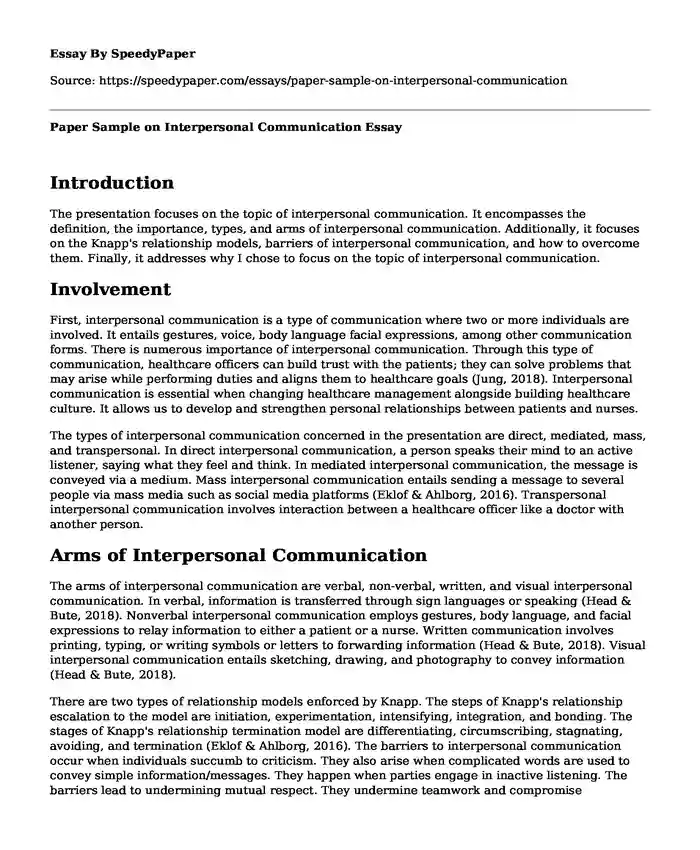
| Type of paper: | Essay |
| Categories: | Interpersonal communication |
| Pages: | 3 |
| Wordcount: | 683 words |
Introduction
The presentation focuses on the topic of interpersonal communication. It encompasses the definition, the importance, types, and arms of interpersonal communication. Additionally, it focuses on the Knapp's relationship models, barriers of interpersonal communication, and how to overcome them. Finally, it addresses why I chose to focus on the topic of interpersonal communication.
Involvement
First, interpersonal communication is a type of communication where two or more individuals are involved. It entails gestures, voice, body language facial expressions, among other communication forms. There is numerous importance of interpersonal communication. Through this type of communication, healthcare officers can build trust with the patients; they can solve problems that may arise while performing duties and aligns them to healthcare goals (Jung, 2018). Interpersonal communication is essential when changing healthcare management alongside building healthcare culture. It allows us to develop and strengthen personal relationships between patients and nurses.
The types of interpersonal communication concerned in the presentation are direct, mediated, mass, and transpersonal. In direct interpersonal communication, a person speaks their mind to an active listener, saying what they feel and think. In mediated interpersonal communication, the message is conveyed via a medium. Mass interpersonal communication entails sending a message to several people via mass media such as social media platforms (Eklof & Ahlborg, 2016). Transpersonal interpersonal communication involves interaction between a healthcare officer like a doctor with another person.
Arms of Interpersonal Communication
The arms of interpersonal communication are verbal, non-verbal, written, and visual interpersonal communication. In verbal, information is transferred through sign languages or speaking (Head & Bute, 2018). Nonverbal interpersonal communication employs gestures, body language, and facial expressions to relay information to either a patient or a nurse. Written communication involves printing, typing, or writing symbols or letters to forwarding information (Head & Bute, 2018). Visual interpersonal communication entails sketching, drawing, and photography to convey information (Head & Bute, 2018).
There are two types of relationship models enforced by Knapp. The steps of Knapp's relationship escalation to the model are initiation, experimentation, intensifying, integration, and bonding. The stages of Knapp's relationship termination model are differentiating, circumscribing, stagnating, avoiding, and termination (Eklof & Ahlborg, 2016). The barriers to interpersonal communication occur when individuals succumb to criticism. They also arise when complicated words are used to convey simple information/messages. They happen when parties engage in inactive listening. The barriers lead to undermining mutual respect. They undermine teamwork and compromise negotiation.
Conclusion
The measures to overcome the barriers of interpersonal communication are using simple words to replace the complicated ones (Head & Bute, 2018). Other measures include simplifying the type of language used, incorporating nonverbal modes of communication, and engaging active listening, encouraging the parties to keep composure (Gianfredi et al., 2018). Discouraging criticism from the speaker is also essential.
The reason I selected this topic is that it promotes understanding relationships between the healthcare worker and the patient in identifying the needs and problems of the patient. It also encourages teamwork with other healthcare providers (Gianfredi et al., 2018). It is very crucial to study interpersonal communication in other to eliminate barriers in inpatient care. The topic allows us to acknowledge the diverse ways of improving the quality of healthcare delivery.
References
Eklof, M., & Ahlborg Jr, G. (2016). Improving communication among healthcare workers: a controlled study. Journal of Workplace Learning.
https://www.emerald.com/insight/content/doi/10.1108/JWL-06-2015-0050/full/html?casa_token=3_F_M_sKZB4AAAAA:2fEnVjkeRzxEk1AaHHdwnHS30a9qL63DJwmRVhvxe7nVIX3-jfRlLC40Ip6FAAXzptD2KjhtWEiqibjmjVQ2ZOfc6qrjfBrtLsbM2VIzB0j3hZhr5S0j
Gianfredi, V., Grisci, C., Nucci, D., Parisi, V., & Moretti, M. (2018). Communication in health. Recenti progressi in medicina, 109(7), 374-383.
https://europepmc.org/article/med/30087500
Head, K. J., & Bute, J. J. (2018). The influence of everyday interpersonal communication on the medical encounter: An extension of street's ecological model. Health communication, 33(6), 786-792. https://www.tandfonline.com/doi/abs/10.1080/10410236.2017.1306474?casa_token=2BpZ39zk20sAAAAA:cs6wxumGmJg5SbKzVAEnR3he-zYuMvVcWGmgx3ao6H2IExhBj2AXKfHpAQqyH1_LnuKlsMacWiJRbpjN
Jung, S. J. (2018). The Effects of Supplementary Education Awareness on Interpersonal Communication for Health Care Providers. Journal of the Korea Academia-Industrial cooperation Society, 19(11), 411-420. https://www.koreascience.or.kr/article/JAKO201809454741356.page.
Cite this page
Paper Sample on Interpersonal Communication. (2023, Dec 12). Retrieved from https://speedypaper.com/essays/paper-sample-on-interpersonal-communication
Request Removal
If you are the original author of this essay and no longer wish to have it published on the SpeedyPaper website, please click below to request its removal:
- Essay Sample Describing the Group Proposal Experience
- Essay Example with a Movie Review for Breakfast Club
- Free Essay Sample about Challenges of Workplace Communication
- What Are the Impacts of Long-distance Relationships on Interpersonal Communication? Essay Sample
- Free Essay Example. Body Language Messages
- Essay Example - Historical Aspects of Artist Management
- Free Essay on Concepts of Aging: Idea for an Internet Home Page
Popular categories




